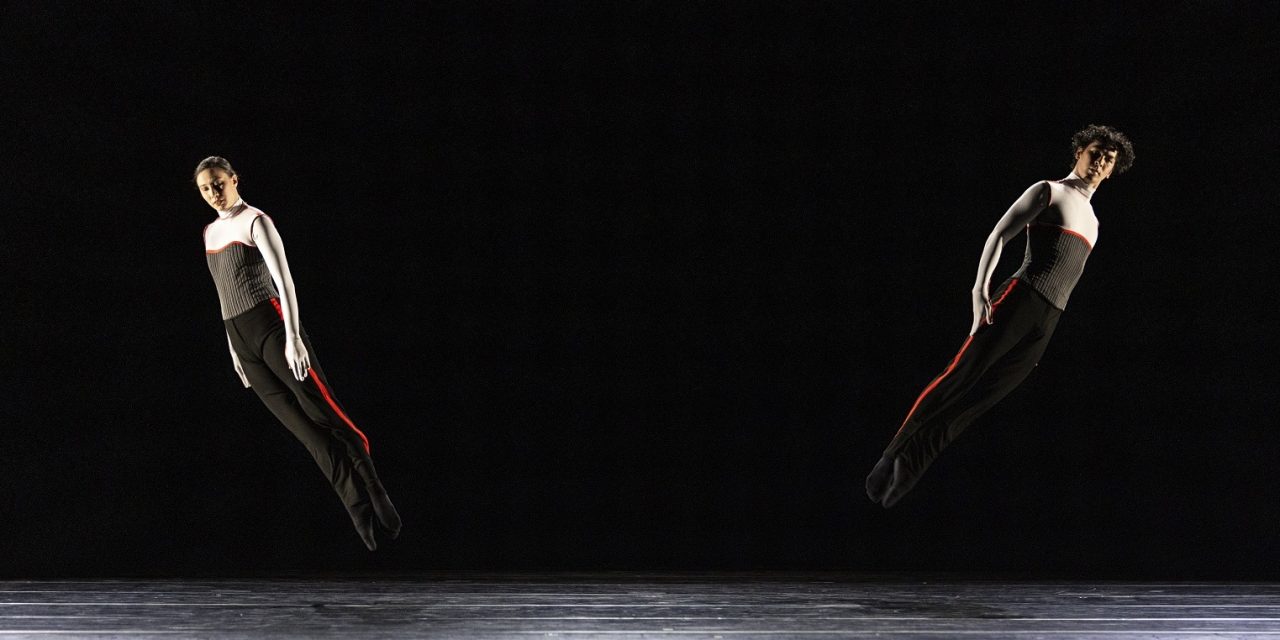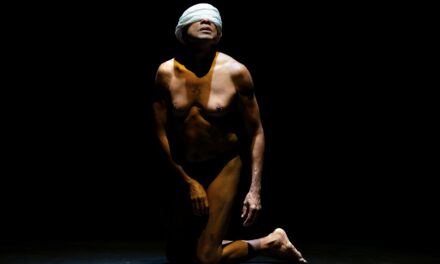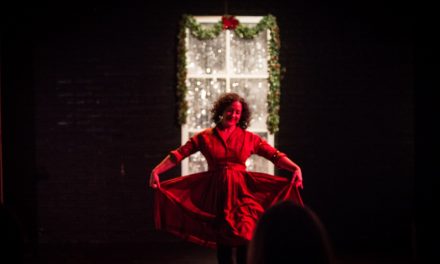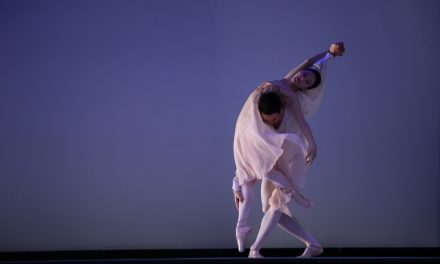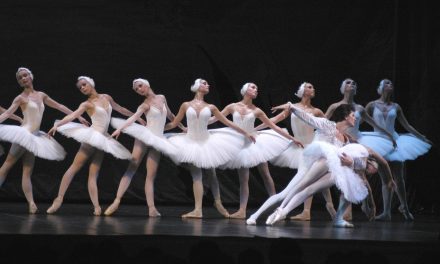Pacific Northwest Ballet’s (PNB) Artistic Director, Peter Boal and the Nesholm Family Foundation presented an evening of three digital recorded pieces for a program called BOUNDLESS. The pieces reflected the spirit and it’s indomitable need to create. They were done by three stellar choreographers, Penny Saunders, Alejandro Cerrudo, and the brilliant Jessica Lang. Much was accomplished in the lull in theatre and dance during the Pandemic which reflected their individual creative dauntlessness.
The first in the series of works was done by the prolific choreographer, Penny Saunders, and her homage to Wonderland which honors the marvel and magic of live theater. As a seasoned performer and choreographer, Saunders has taken her experience with numerous well-known companies and graced PNB with her whimsical Wonderland, a grab-bag of choreographic and musical styles. Its beginnings, during the pandemic was in an empty theatre with the hope of Premiering the work live. This wish finally came true on March 17 through the 26, 2023, Live at McCaw Hall.
In observing this work it is both fascinating and uneven. In Saunders’ choreography, there are moments of playful brilliance, along with segments that appear to be in the realm of the ordinary in this otherwise unique and, in some cases, wonderous work.
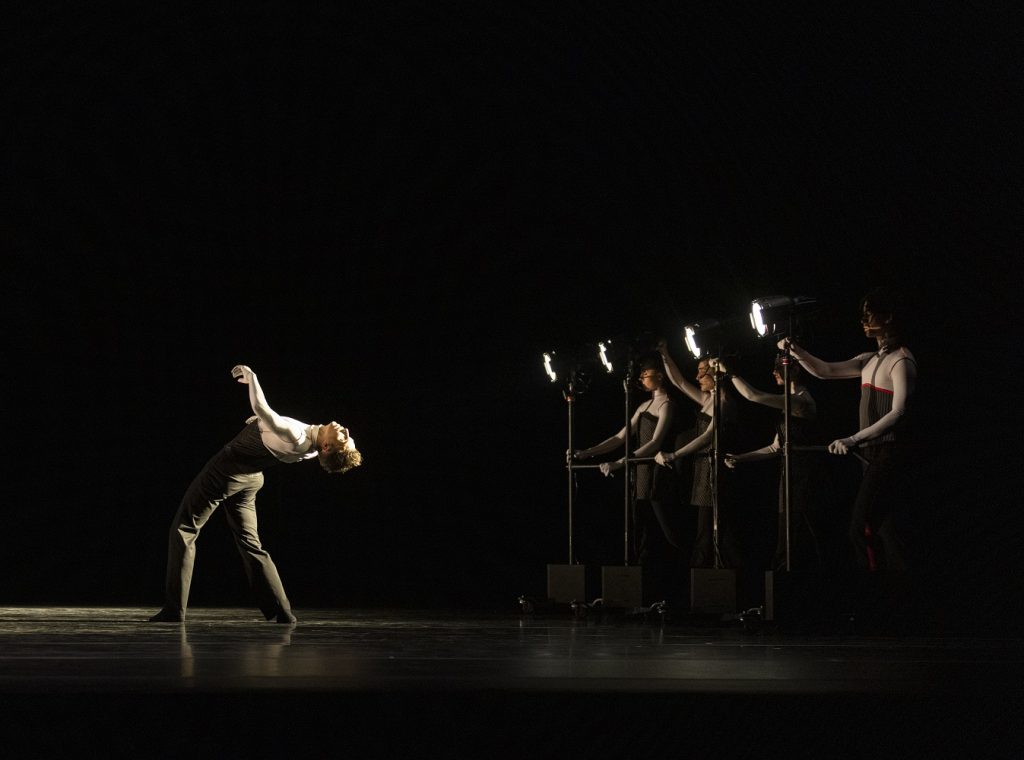
Pacific Northwest Ballet principal dancer Lucien Postlewaite with company dancers in Penny Saunders’ “Wonderland” – Photo © Angela Sterling
Saunders begins with Elle Macy’s whimsical not-quite-usual conducting skills. Only partially seen from the pit, she slyly begins the evening with extravagant conducting motions, checking back with the audience as she banters back and forth with the animated white glove-handed dancers Dylan Calahan, Ashton Edwards, Connor Horton, Zsilas Michael Hughes, Rosalyn Hutsell, Larry Lancaster, Joh Morrill, and Destiny Wimpye, that pop out from beneath the heavy red velvet curtain. This definitely introduces the evening to a wonder-land of fun and joyful play. The opening music by Michael Wall (“Conductor’s tap” and “Heaven’s Dust”) is an apt choice.
Costumes by Melanie Burgess begin with black flamenco pants and white long sleeved fitted shirts extending to gloved hands. Men wear white tops, women in grey and/or colorful see-thru diaphanous tunics help allow full freedom in the languorous movements.
After the mischievous start, Mark Cuddihee and Lucien Postlewaite are found splitting focus in the angular empty balcony on either side of the conductor. Saunder’s experiment with angles in the aloneness of two images countering one another appears in a mournful churchly medieval piece (Goude: Aux Solitudes, “Fermer Les Yeux Pour Voir). It is haunting, and creates a fascinating moment of meditation, yet without resolution it became overlong.
The pairing of Macy with Dylan Wald in their childlike “pit” play with Hugues Le Bars French Rap Rhythms in “Derap” is fun and magical. Le Bars’ vocals engage the couple in funky frolicking, and making Dylan appear and disappear in a zany energetic romp.
Moving on in the piece, a lovely moment finds Elizabeth Murphy on the darkened stage appearing with the halting strains of Erik Satie as she performs a moving and controlled adagio.
Macy and Wald later are discovered on a bench side by side, in a quiet moment of reminiscences. Strains of Alexadre Desplat’s Beautiful Dreamer by Stephen Foster takes us to another time. Their pas de deux appears weightless, and with embraces and effortless connection, they never leave the bench where we found them. When they work together it’s like watching a play with silent dialogue, so beautifully performed.
Madison Rayn Abeo, Cecilia Ilieisu, Yuki Takahashi are engaging in their pas de trois in front of the curtain preparing us for what is to come. Cameras and light then capture the essence of the dancer’s pas de deux, trois and quatre beautifully and thoughtfully choreographed and executed while the camara’s are shedding light on performers that seems to be viewing the humanity of each movement, and person in time. Then once again the Conductor takes center stage bringing an end to the fantasy that is the wonder of theatre.
After Intermission, Alejandro Cerrudo contributed his Black on Black on Black. His minimal choice in this piece was to go with a filmic sensibility using a series of reveals and blackouts to pick up life in the middle of action, then release it. The piece begins with strobed running images of people against a dark scrim. Then two male dancers begin with a pulsed movement then into the driving rhythms of The Hidden Orchestra’s, “East London Street.” The groups move in and out of formations, braiding and retreating. As is Cerrudo’s sensibility with this opening, the dramatic and powerful makes its point as individuals begin breaking out, break up and backing away …then Black Out!
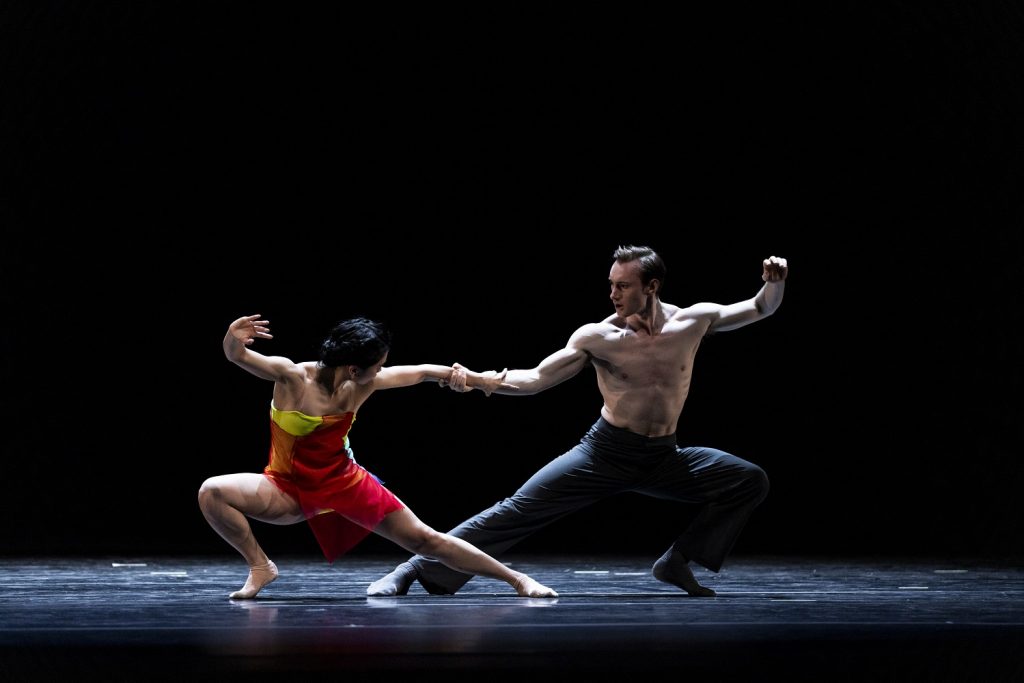
Pacific Northwest Ballet principal dancers Angelica Generosa and James Kirby Rogers in Alejandro Cerrudo’s “Black on Black on Black” – Photo © Angela Sterling
The company of dancers; Christopher D’Ariano, Leah Terada, Luther DeMyer, Elizabeth Murphy, Elle Macy, Noah Martzall, Juliet Prine, Yuki Takahashi, Angelica Generosa, James Kirby Rogers with Dylan Calahan, Connor Horton, Zsilas Michael Hughes, Joh Morrill manage to settle into partnership with music by Oliver Coates from the film The Stranger; and “Mariupol” by Natalia Tsupryk. There’s then a passionate pas de deux that ensues when a woman is met by a man who appears from the shadows. Embracing, he lifts her weightless body in an overhead lift and holds her with loving care gliding her across the floor and giving way to their stunning dance for two… Then …Black Out!
Later a mechanical moment with six male dancers who keep a female dancer nearly always air-born. They defy gravity as they skim her diminutive body across the floor and in the air in slow motion, then spirit her down the line of males barely an inch from the ground. Later in the piece, a theatrical tool, a colorful wipe with shimmering curtains, acting like a blackout that introduces the next dance section. Was this an invention at its highest level, or perhaps just a trick?….Oh, then Black Out!
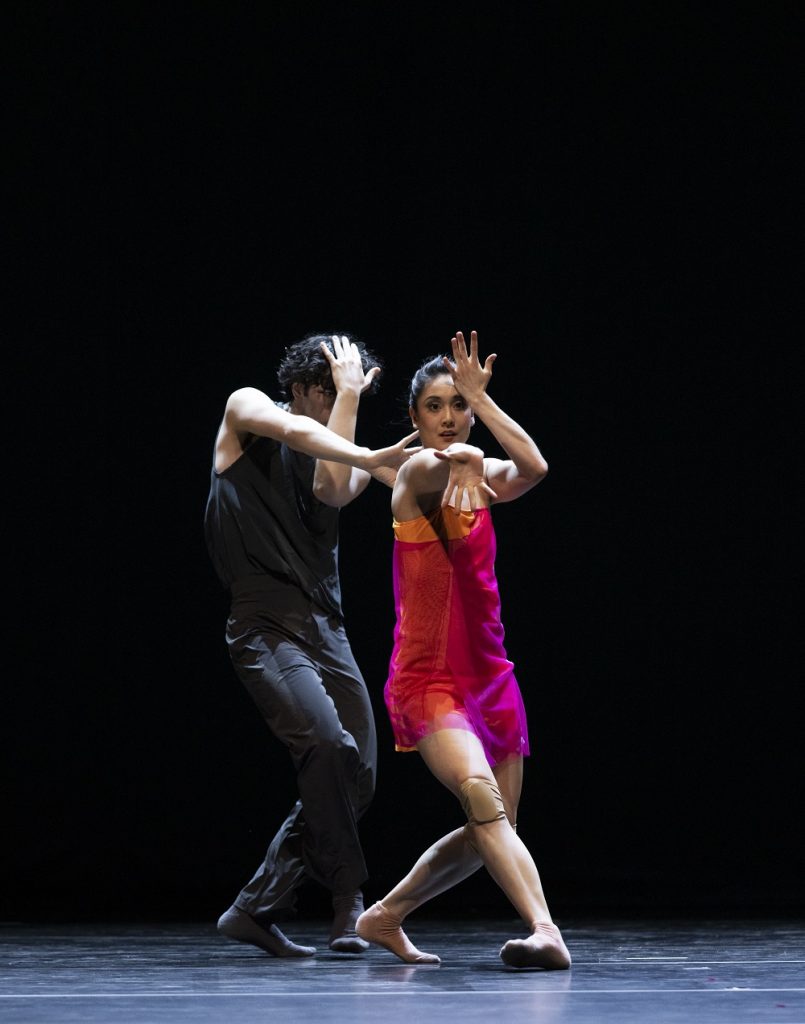
Pacific Northwest Ballet soloists Christopher D’Ariano and Leah Terada in Alejandro Cerrudo’s “Black on Black on Black” – Photo © Angela Sterling
As we go forward with solos, duets, and groups this excellent company of truly beautiful dancers reveal their amazing abilities. Yes, lovely dance, but it is now in need of a concept, more exploration perhaps? Cerrudo of course, will always present a good level of competence. However, this particular piece appeared not to have time for discovery nor thoughtful molding and sculpting in baking this into a piece of art. Black on Black on Black needs more bones to be memorable.
The real work of genius was Jessica Lang’s Let Me Mingle Tears With Thee. This World Premiere was the only piece of the evening done with a live orchestra. The conductor, Emil de Cou, with Soprano, Christina Siemens and Alto, Sarra Sharif Doyle, assured clarity and spiritual connection to the stirring Stabat Mater, by Renaissance master Giovanni Battista Pergolesi, written in 1736 as he lie dying of TB at age 26. Lang’s clarity of vision, her exceptional musicality and devotion to the subject inspired freedom and ease of movement in the dancers. Her intelligence and emotional discernment clearly was sustained in the brilliant design of the piece. the sparce and effective lighting by Carolyn Wong and the Scenic design and costumes, by the gifted Jillian Lewis that moved from misty greys, smoky blues, light beige and browns slowly transitioned to reds, mauve’s yellows and teal. This piece gave these paired creatives significant freedom to move the audience.
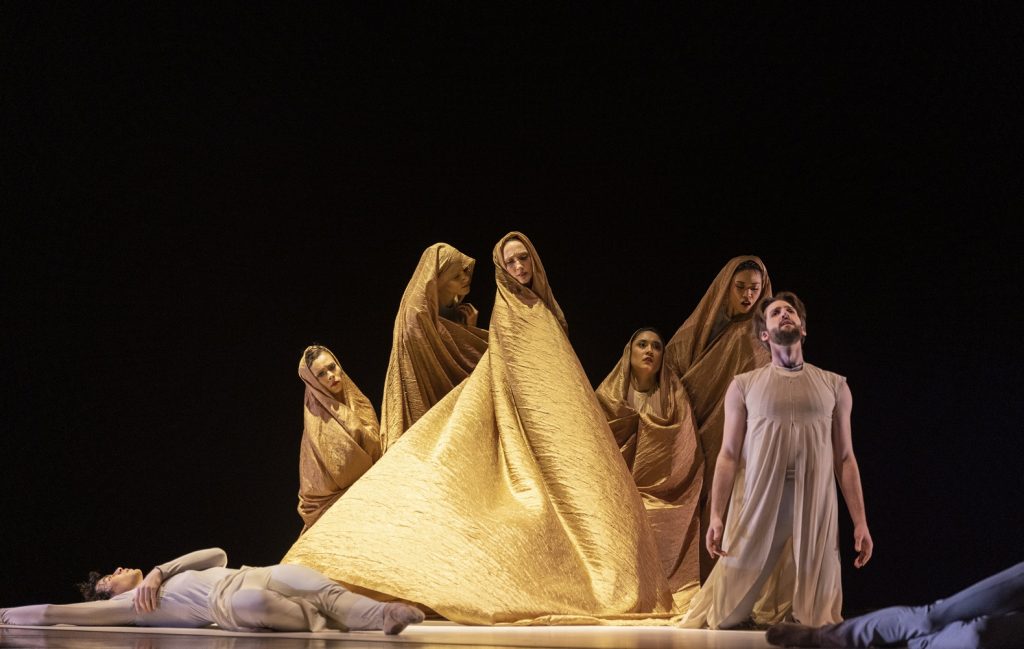
Pacific Northwest Ballet company dancers in Jessica Lang’s “Let Me Mingle Tears With Thee” – Photo © Angela Sterling
There were many highlights in this stunning work. The emotional music and a stark Cross created by Wong’s lighting instantly identified this piece. It was difficult not to notice Miles Pertl’s presence. His effortless and powerful lyrical work, so generous in the pas de deux, Fac, ut portem Christi mortem (Make me bear the death of Christ) with James Yoichi Moore’s excellent partnership, was so moving as to appear unearthly. The stunning focused work of Elizabeth Murphy who stood, unmoving, shrouded in a gold mantel nearly covering the length of the stage; Christopher D’Ariano and Leah Terada’s facile lifts gliding through space in their Pas de deux, and D’Ariano wonderful partnering with the spirited Angelica Generosa. The superb transition presented in “She watched as her son surrendered his spirit” was dramatic in its very essence. This work exposed the unbridled talent of this company of dancers: Pertl, Murphy, D’ariano, Terada, Generosa, Kuu Sakurag , Luther DeMyer Audrey Malek · Clara Ruf Maldonado, who in their commitment to the work were capable of enhancing this brilliant work.
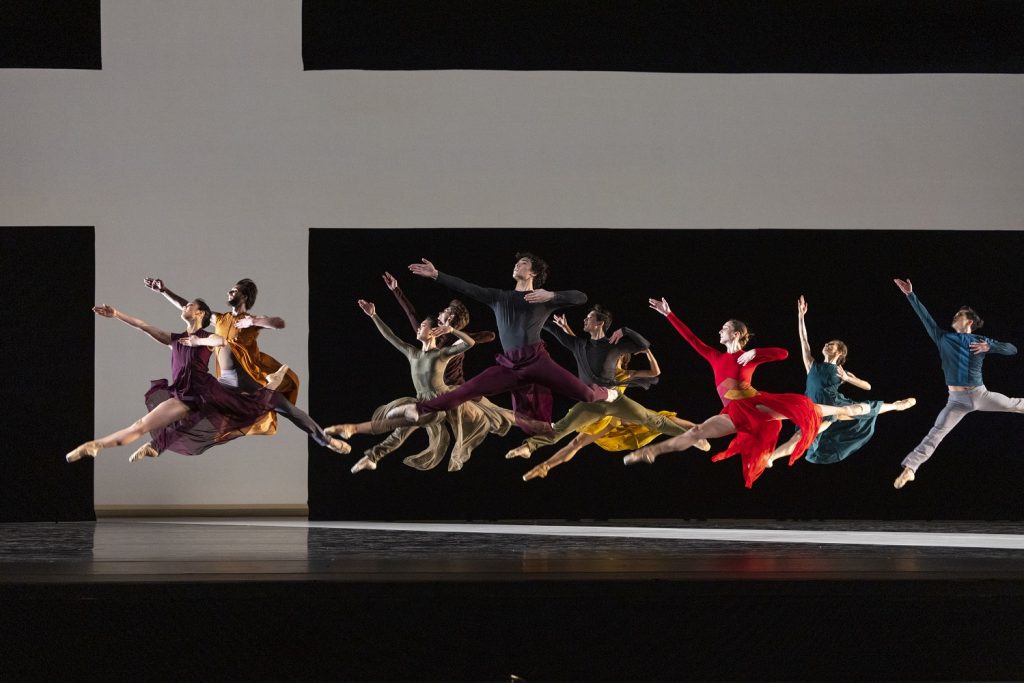
Pacific Northwest Ballet company dancers in Jessica Lang’s “Let Me Mingle Tears With Thee” – Photo © Angela Sterling
Lang’s serious reverence and sensitive interpretation of Pergolesi’s masterpiece, her discipline and understanding of choreographic design, her dancers and artistic partnerships evoked a spirit and physical freedom that more than lived up to the title unbound in this evening’s program.
Run, don’t walk to see this excellent program of PNB’s new works. The dancers dance “as though their life depended on it.” BOUNDLESS is a treat you will not soon forget.
For more information on Pacific Northwest Ballet, please visit their website.
Written by Joanne DiVito for LA Dance Chronicle.
Featured image: Pacific Northwest Ballet corps de ballet dancer Genevieve Waldorf and soloist Christopher D’Ariano in Penny Saunders’ Wonderland – Photo © Angela Sterling

